Connie Kerbs's Blog, page 2
October 16, 2015
Famous Mommy Moxie – Part 2
No page on Mommy Moxie would be complete without the icon, the sage, the guru, the Nobel Peace Prized, the Saint of “Mothering,” in the larger, community sense: Anjezë Gonxhe Bojaxhiu. Also known as the one, the only: Mother Teresa.
Note: rather than try to maintain an exhaustive list of links, please use this list of famously recognized “mothers,” as a reference point. Any of these names could be easily searched, Googled or Wiki’d with fabulous results.
Abigail Adams - married to a US president, also the mother of a president.
Rose Kennedy - strong mother of President John F. Kennedy.
Margaret Thatcher - mother, first woman Prime Minister of Britain.
Celine Dion - "test tube" mom, music diva.
Lydia Maria Child – one of the first to write books in the early 19th century to guide mothers in raising their children and running a home; she was also an active abolitionist
Lucy Stone - a suffrage leader, so was her daughter, Alice Stone Blackwell.
Elizabeth, Queen Mum - Elizabeth Bowes-Lyon, mother of Queen Elizabeth II.
Marie Osmond - biological and adoptive mother of 7, entertainer/singer.
Eleanor of Aquitaine - mother of three kings; her daughters married into the royal houses of Europe; she's been called the Mother of Europe.
Bobbi McCaughey - mother of sextuplets.
Chris Evert - athlete mom, three-time Wimbledon champ.
Mary, Queen of Scots - mother of James I of England, first Stuart king.
Toni Morrison - mother, writer, first African-American to win the Nobel Prize in literature.
Elizabeth Cady Stanton - mother of eight; one daughter also became a leader in the women’s suffrage movement.
Wilma Mankiller - mother, first woman Chief of the Cherokee Nation.
Mother Jones - called the "most dangerous woman in America," lost all four of her children to a yellow fever epidemic long before her career as a labor organizer.
Jacqueline Kennedy Onassis - mother of John F. Kennedy Jr., Caroline Kennedy, and the short-lived Patrick Kennedy. Known for her beauty, grace and charm as a beloved First Lady to one of America’s most popular presidents, before she was widowed on one of the most infamous days in American history.
Anne Morrow Lindbergh - a pilot herself, married to the famous Charles Lindbergh; their son was the subject of a tragic kidnapping.
Mary Wollstonecraft - famous as an early feminist; her daughter, Mary Shelley, wrote the novel Frankenstein.
Clara Barton - founder of the Red Cross and "mother" to thousands of wounded soldiers.
Grandma Moses - mother and grandmother, and a famous painter who started painting in her 70s.
Note: rather than try to maintain an exhaustive list of links, please use this list of famously recognized “mothers,” as a reference point. Any of these names could be easily searched, Googled or Wiki’d with fabulous results.
Abigail Adams - married to a US president, also the mother of a president.
Rose Kennedy - strong mother of President John F. Kennedy.
Margaret Thatcher - mother, first woman Prime Minister of Britain.
Celine Dion - "test tube" mom, music diva.
Lydia Maria Child – one of the first to write books in the early 19th century to guide mothers in raising their children and running a home; she was also an active abolitionist
Lucy Stone - a suffrage leader, so was her daughter, Alice Stone Blackwell.
Elizabeth, Queen Mum - Elizabeth Bowes-Lyon, mother of Queen Elizabeth II.
Marie Osmond - biological and adoptive mother of 7, entertainer/singer.
Eleanor of Aquitaine - mother of three kings; her daughters married into the royal houses of Europe; she's been called the Mother of Europe.
Bobbi McCaughey - mother of sextuplets.
Chris Evert - athlete mom, three-time Wimbledon champ.
Mary, Queen of Scots - mother of James I of England, first Stuart king.
Toni Morrison - mother, writer, first African-American to win the Nobel Prize in literature.
Elizabeth Cady Stanton - mother of eight; one daughter also became a leader in the women’s suffrage movement.
Wilma Mankiller - mother, first woman Chief of the Cherokee Nation.
Mother Jones - called the "most dangerous woman in America," lost all four of her children to a yellow fever epidemic long before her career as a labor organizer.
Jacqueline Kennedy Onassis - mother of John F. Kennedy Jr., Caroline Kennedy, and the short-lived Patrick Kennedy. Known for her beauty, grace and charm as a beloved First Lady to one of America’s most popular presidents, before she was widowed on one of the most infamous days in American history.
Anne Morrow Lindbergh - a pilot herself, married to the famous Charles Lindbergh; their son was the subject of a tragic kidnapping.
Mary Wollstonecraft - famous as an early feminist; her daughter, Mary Shelley, wrote the novel Frankenstein.
Clara Barton - founder of the Red Cross and "mother" to thousands of wounded soldiers.
Grandma Moses - mother and grandmother, and a famous painter who started painting in her 70s.
Published on October 16, 2015 17:59
October 13, 2015
Famous Mommy Moxie – Part 1
Helping Harlem
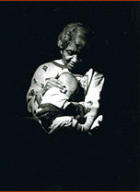 Clara Hale (1905-1992) spent 52 years dedicated to the hoping and helping of Harlem’s less fortunate. The Hale House, a home for drug-addicted and AIDS-infected children, was the crowning jewel of her valiant humanitarian efforts that made a difference to thousands of children and their struggling mothers. Clara Hale championed principles of responsibility and self-determination.
Clara Hale (1905-1992) spent 52 years dedicated to the hoping and helping of Harlem’s less fortunate. The Hale House, a home for drug-addicted and AIDS-infected children, was the crowning jewel of her valiant humanitarian efforts that made a difference to thousands of children and their struggling mothers. Clara Hale championed principles of responsibility and self-determination.
Through her own single mother’s resolve and example of overcoming difficult circumstances for her children, and Ms. Hale’s devotion to her three children, she was inspired to make a difference to others who were suffering around her. She effectively advocated for an entire community in need of mothering.
The Mother of Modern Physics
 Marie Curie was the mother of modern physics, as well as a real mother whose children were raised by their widowed mother (Madam Curie) who was the perfect example of mommy moxie.
Marie Curie was the mother of modern physics, as well as a real mother whose children were raised by their widowed mother (Madam Curie) who was the perfect example of mommy moxie.
An Extra-Ordinary Mother
Maria Magdalena van Beethoven (1746-87) – Ludwig Van Beethoven's mother. She was a widowed single mother by the time she was 18. Her marriage to her second husband, Ludwig’s father, was plagued with prejudice from her in-laws over the perceived lower class status of her family, (which was debatable in reality), and their denigrating attitude towards her for being previously married (widowed).
Her husband’s eventual disconnect with her due to his problems, including alcoholism, made the sting of her father-in-law’s reference to her as a lowly, “Chamber Maid,” seem a minor irritation. In her young life, she would bury more than half of her nine children, including her first born just before being widowed, and several of her children were blind and/or deaf or partially so, (including Ludwig.) She was a mother that took courage to a heroic level when she single-handedly saved her several surviving children in a town fire where few others escaped.
Ludwig Van Beethovan’s sentiments at her death were indicative of the deep, appreciation and love he had for his dear mother who had suffered tremendous grief in her life – but whose suffering and sorrow only seemed to deepen her convictions of loyalty, dedication and compassion for her children.
NOTE: This was at a time when it wasn’t common for children with disabilities to even survive – let alone rise to epic composer acclaim.
A Shoshone Mom
 Sacagawea made no small contribution to the success of the Lewis and Clark Expedition – one of the most historically, culturally, geographical and politically significant explorations in U.S. History.
Sacagawea made no small contribution to the success of the Lewis and Clark Expedition – one of the most historically, culturally, geographical and politically significant explorations in U.S. History.
She gave birth along the difficult journey, and then cared attentively for the child the duration of the arduous continental trip. She did this all in the shadow of domestic abuse, and essentially of her own free will. Even after a miraculous, unexpected long-lost family reunion in the middle of the epic journey she chose to stay with the expedition of her own accord after having been given the choice to remain with her re-discovered, native family, whom she had been separated from against her will in childhood. Her decision at that juncture was pivotal to remain with the expedition. And with an abusive husband to boot.
Her willingness to carry on would ensure the endeavor’s success to completion, and to support the group she had already, on multiple occasions, offered life-saving, interpretive and survival skills. After what would have been this most difficult decision to leave the family she had just been miraculously reunited with, she proved nonetheless essential to the expedition’s successful return home. This self-sacrificing resolution spoke to her character and courage. All the while she toted and cared well for her infant. The National American Woman Suffrage Association of the early twentieth century adopted her as a symbol of women's worth and independence, erecting several statues and plaques in her memory, and doing much to spread the story of her accomplishments, and the importance of her contributions.
In 2000, the United States Mint issued the Sacagawea dollar coin in her honor, depicting Sacagawea and her son, Jean Baptiste Charbonneau. Because no contemporary image of Sacagawea exists, the face on the coin was modeled on a modern Shoshone-Bannock woman named Randy'L He-dow Teton. In 2001, Sacagawea was given the title of Honorary Sergeant, Regular Army, by then-president Bill Clinton.
First Lady of the United States
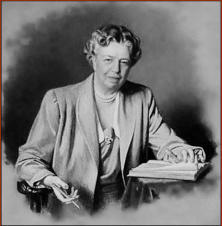 Using her intellect and influence, she redefined what it meant to be a female member of the upper echelons of society, First Lady of New York, First Lady of the United States, and ultimately she expanded the role of women in society. Eleanor Roosevelt was experienced with Public Relations, Politics, Speaker, Writer, a formidable progressive and advocate, wife, longest serving First Lady, and a notable mother of six children.
Using her intellect and influence, she redefined what it meant to be a female member of the upper echelons of society, First Lady of New York, First Lady of the United States, and ultimately she expanded the role of women in society. Eleanor Roosevelt was experienced with Public Relations, Politics, Speaker, Writer, a formidable progressive and advocate, wife, longest serving First Lady, and a notable mother of six children.
All she knew for certain upon entering the White House was that she would be active in word and deed, especially in light of the Great Depression’s havoc upon the nation, and its devastation upon the lives of millions of Americans.
Her invaluable experience and previous work in politics, the media, education, and women’s issues, as well as her experience as an attentive mother, gave her dynamic direction and energized her priorities. In terms of her robust life experiences, her progressive vision as First Lady, and the lasting positive impact she had upon a nation, Eleanor Roosevelt not only forged a lasting impression but she also redefined the role in meaningful ways. She is revered to this day as one of the finest, most influential people to have ever lived.
Now that’s what I call “Ever So Much More Mommy Moxie!”
 Clara Hale (1905-1992) spent 52 years dedicated to the hoping and helping of Harlem’s less fortunate. The Hale House, a home for drug-addicted and AIDS-infected children, was the crowning jewel of her valiant humanitarian efforts that made a difference to thousands of children and their struggling mothers. Clara Hale championed principles of responsibility and self-determination.
Clara Hale (1905-1992) spent 52 years dedicated to the hoping and helping of Harlem’s less fortunate. The Hale House, a home for drug-addicted and AIDS-infected children, was the crowning jewel of her valiant humanitarian efforts that made a difference to thousands of children and their struggling mothers. Clara Hale championed principles of responsibility and self-determination.
Through her own single mother’s resolve and example of overcoming difficult circumstances for her children, and Ms. Hale’s devotion to her three children, she was inspired to make a difference to others who were suffering around her. She effectively advocated for an entire community in need of mothering.
The Mother of Modern Physics
 Marie Curie was the mother of modern physics, as well as a real mother whose children were raised by their widowed mother (Madam Curie) who was the perfect example of mommy moxie.
Marie Curie was the mother of modern physics, as well as a real mother whose children were raised by their widowed mother (Madam Curie) who was the perfect example of mommy moxie. An Extra-Ordinary Mother
Maria Magdalena van Beethoven (1746-87) – Ludwig Van Beethoven's mother. She was a widowed single mother by the time she was 18. Her marriage to her second husband, Ludwig’s father, was plagued with prejudice from her in-laws over the perceived lower class status of her family, (which was debatable in reality), and their denigrating attitude towards her for being previously married (widowed).
Her husband’s eventual disconnect with her due to his problems, including alcoholism, made the sting of her father-in-law’s reference to her as a lowly, “Chamber Maid,” seem a minor irritation. In her young life, she would bury more than half of her nine children, including her first born just before being widowed, and several of her children were blind and/or deaf or partially so, (including Ludwig.) She was a mother that took courage to a heroic level when she single-handedly saved her several surviving children in a town fire where few others escaped.
Ludwig Van Beethovan’s sentiments at her death were indicative of the deep, appreciation and love he had for his dear mother who had suffered tremendous grief in her life – but whose suffering and sorrow only seemed to deepen her convictions of loyalty, dedication and compassion for her children.
NOTE: This was at a time when it wasn’t common for children with disabilities to even survive – let alone rise to epic composer acclaim.
A Shoshone Mom
 Sacagawea made no small contribution to the success of the Lewis and Clark Expedition – one of the most historically, culturally, geographical and politically significant explorations in U.S. History.
Sacagawea made no small contribution to the success of the Lewis and Clark Expedition – one of the most historically, culturally, geographical and politically significant explorations in U.S. History.She gave birth along the difficult journey, and then cared attentively for the child the duration of the arduous continental trip. She did this all in the shadow of domestic abuse, and essentially of her own free will. Even after a miraculous, unexpected long-lost family reunion in the middle of the epic journey she chose to stay with the expedition of her own accord after having been given the choice to remain with her re-discovered, native family, whom she had been separated from against her will in childhood. Her decision at that juncture was pivotal to remain with the expedition. And with an abusive husband to boot.
Her willingness to carry on would ensure the endeavor’s success to completion, and to support the group she had already, on multiple occasions, offered life-saving, interpretive and survival skills. After what would have been this most difficult decision to leave the family she had just been miraculously reunited with, she proved nonetheless essential to the expedition’s successful return home. This self-sacrificing resolution spoke to her character and courage. All the while she toted and cared well for her infant. The National American Woman Suffrage Association of the early twentieth century adopted her as a symbol of women's worth and independence, erecting several statues and plaques in her memory, and doing much to spread the story of her accomplishments, and the importance of her contributions.
In 2000, the United States Mint issued the Sacagawea dollar coin in her honor, depicting Sacagawea and her son, Jean Baptiste Charbonneau. Because no contemporary image of Sacagawea exists, the face on the coin was modeled on a modern Shoshone-Bannock woman named Randy'L He-dow Teton. In 2001, Sacagawea was given the title of Honorary Sergeant, Regular Army, by then-president Bill Clinton.
First Lady of the United States
 Using her intellect and influence, she redefined what it meant to be a female member of the upper echelons of society, First Lady of New York, First Lady of the United States, and ultimately she expanded the role of women in society. Eleanor Roosevelt was experienced with Public Relations, Politics, Speaker, Writer, a formidable progressive and advocate, wife, longest serving First Lady, and a notable mother of six children.
Using her intellect and influence, she redefined what it meant to be a female member of the upper echelons of society, First Lady of New York, First Lady of the United States, and ultimately she expanded the role of women in society. Eleanor Roosevelt was experienced with Public Relations, Politics, Speaker, Writer, a formidable progressive and advocate, wife, longest serving First Lady, and a notable mother of six children.All she knew for certain upon entering the White House was that she would be active in word and deed, especially in light of the Great Depression’s havoc upon the nation, and its devastation upon the lives of millions of Americans.
Her invaluable experience and previous work in politics, the media, education, and women’s issues, as well as her experience as an attentive mother, gave her dynamic direction and energized her priorities. In terms of her robust life experiences, her progressive vision as First Lady, and the lasting positive impact she had upon a nation, Eleanor Roosevelt not only forged a lasting impression but she also redefined the role in meaningful ways. She is revered to this day as one of the finest, most influential people to have ever lived.
Now that’s what I call “Ever So Much More Mommy Moxie!”
Published on October 13, 2015 14:37
October 8, 2015
Ever So Much More Mommy Moxie
Mother Defined:
1. A woman who births, adopts or raises a child.2. A woman who creates, originates, or founds something.
3. A creative source; an origin: Desperation is the mother of invention.
4. Used as a title of respect: Mother Superior
5. Maternal tenderness and attentiveness; to nourish & protect.
 We wouldn’t be here without her. We owe our very existence to her. Our mothers (or lack thereof) significantly shape our life, our initial personality, and even our life-long potentiality. A mother is usually the first person a child knows, and it is through our mothers that we first view everything and everyone else. It is through our mothers that our view of the world is formed.
We wouldn’t be here without her. We owe our very existence to her. Our mothers (or lack thereof) significantly shape our life, our initial personality, and even our life-long potentiality. A mother is usually the first person a child knows, and it is through our mothers that we first view everything and everyone else. It is through our mothers that our view of the world is formed.
The term “mother,” traditionally means the one who gives birth to a child, but it can also mean the one who brings up a child, even if different than the biological mother. A broader definition of the word also refers to women who have made a significant difference to those around them, or their society. Women in this category, some biological or adoptive mothers and some not, spent a tremendous amount of time, energy and personal resources for the caring of others, a community, or greater humanity.
There are many well-known mothers who are acclaimed for their achievements – too many in fact, to make even close to a complete list. These are matrons revered for their mothering, as well as personal sacrifices they made for a greater purpose. They are remembered for the substantial, important changes they were an impetus to. These are women imbued with a passion for an important cause. These are women who were inspiring in their time and remain so through the generations. These are women whose lives were the epitome of other-orientation, hearty compassion, intense commitment, and robust integrity.
These are women whose courage and tenacity found a way to transcend the many racial, cultural, economic, religious and political barriers of their day. These are amazing, heroic women, whose stories can continue to inspire and encourage us, if only we continue to remember them.
I look forward to sharing examples with you in my next two blog posts. Get ready to be inspired.
1. A woman who births, adopts or raises a child.2. A woman who creates, originates, or founds something.
3. A creative source; an origin: Desperation is the mother of invention.
4. Used as a title of respect: Mother Superior
5. Maternal tenderness and attentiveness; to nourish & protect.
 We wouldn’t be here without her. We owe our very existence to her. Our mothers (or lack thereof) significantly shape our life, our initial personality, and even our life-long potentiality. A mother is usually the first person a child knows, and it is through our mothers that we first view everything and everyone else. It is through our mothers that our view of the world is formed.
We wouldn’t be here without her. We owe our very existence to her. Our mothers (or lack thereof) significantly shape our life, our initial personality, and even our life-long potentiality. A mother is usually the first person a child knows, and it is through our mothers that we first view everything and everyone else. It is through our mothers that our view of the world is formed.The term “mother,” traditionally means the one who gives birth to a child, but it can also mean the one who brings up a child, even if different than the biological mother. A broader definition of the word also refers to women who have made a significant difference to those around them, or their society. Women in this category, some biological or adoptive mothers and some not, spent a tremendous amount of time, energy and personal resources for the caring of others, a community, or greater humanity.
There are many well-known mothers who are acclaimed for their achievements – too many in fact, to make even close to a complete list. These are matrons revered for their mothering, as well as personal sacrifices they made for a greater purpose. They are remembered for the substantial, important changes they were an impetus to. These are women imbued with a passion for an important cause. These are women who were inspiring in their time and remain so through the generations. These are women whose lives were the epitome of other-orientation, hearty compassion, intense commitment, and robust integrity.
These are women whose courage and tenacity found a way to transcend the many racial, cultural, economic, religious and political barriers of their day. These are amazing, heroic women, whose stories can continue to inspire and encourage us, if only we continue to remember them.
I look forward to sharing examples with you in my next two blog posts. Get ready to be inspired.
Published on October 08, 2015 17:10
September 27, 2015
Coaxing Mommy Moxie
 "The hand that rocks the cradle is the hand that rules the world."
"The hand that rocks the cradle is the hand that rules the world."
- William Ross Wallace
As discussed in my earlier blog post Coaxing Moxie, moxie is the term I use to represent the entire self-esteem “package:” the clusters of interconnected traits, decisions and experiences centering on the core of self-esteem. These all work together in a reciprocal, and complex interplay in our life.
Before any of that, however – there was something that set the stage for all the rest. (Drum roll…) Enter, MOM.
The seeds of self-esteem are first planted in early development and are defined through your first social and emotional life experiences, especially EARLY attachment.
Modern research, as well as proverbs of wisdom through the ages, all point to the impact, and importance of quality mothering in the earliest stages of development. One would be hard-pressed to find a hero who wouldn’t credit a mother, or mother-figure in their life for who they became. By the same token, just as unique it is to name a villain whose mother, or lack there-of, didn’t taint the backstory of their life with “mommy issues.”
POINTS OF ATTACHMENT
The theories, types and nuances of attachment are quite in depth. Here is an easily digested nutshell on attachment:Attachment means a person’s ability to develop basic trust in their caregivers and self. The most important tenet of early attachment establishes that an infant needs to develop a close relationship with at least one primary caregiver.The child’s ongoing, successful social and emotional development (self-esteem, and trust in others) depend upon this occurring in deepening stages during the first year of a child’s life.A responsive, consistent caregiver at this stage is essential to provide the physical needs of the child, and to form the framework for the child’s developing attachment into adulthood.Much compelling research and mountains of evidence point to these earliest patterns of attachment affecting an individual’s ability to navigate relationships throughout their life.
MORE ON MOMMY MOXIE
Now that we have laid the groundwork for this important concept of attachment and the vital role caregiving plays in it – let’s talk about what The Fostering Mom has affectionately dubbed “Mommy Moxie.”
MOMMY MOXIE (ultra-mothering) embodies the ALL-IMPORTANT, capable and quality style of caregiving children need to thrive.
The concept encompasses both:
1) The attentive, EARLY, consistent primary caregiving essential for the child’s physical well-being, and to establish healthy patterns of attachment, and intrinsic self-esteem that will carry forward.
2) The energetic, ONGOING, capable nurturing that is pivotal to the child’s continued successful maturation and development beyond infancy, all of which helps a child reach their fullest potential into adulthood.
 Doting Daddy Moxie
Doting Daddy Moxie
Please note that the points made above focus on early primary caregiving, i.e.; the ultra-mothering described above. However, this idea certainly extends to a broader field of caregivers in general, and not just a gender specific parent, such as, “the mother.” Mommy Moxie is simply a term coined to refer to quality caregiving, and ideally, the various individuals in the child’s life which are imbued with this nurturing vigor (including dad, grandma, auntie, etc.).
"I think of myself as mother. I think of men as mother - some men. My son has mothered his son, fathered his son. I don't think you have to be a woman to mother." - Maya Angelou
In a world where it is increasingly less the norm – the Fostering Mom fully embraces the idea that the idealness of both parents’ full availability to a child will play out, as nature intended - in complementary, and specifically different, important ways. Two healthy parents are not duplicative in a child’s life. This is, of course, distinct to the individuals involved, and in accordance with the family’s unique micro-culture.
In other words – both parents are invaluable to a child’s fullest potential. I have a readily admitted strong bias towards believing the optimum environment for both child and parent to flourish is within a thriving family unit, bound by the bonds of a legal, stable marriage. I adamantly believe this is not only what is best for the child, but also for the adults charged with the day to day business of child-rearing, as well as the long-term challenges of establishing and maintaining the family unit. I would also staunchly agree with the idea that this long proven historical arrangement – is of the greatest benefit to society at large.
As a long-time foster/adoptive parent, who has seen parents and families in all stages of functioning, and, unfortunately non-functioning, it is my hope that these pages will be encouraging to any and ALL caregivers in their nurturing of children – wherever they be in the imperfect process of parenting trial and error. Besides the mother, father, or any surrogate primary caregivers in a child’s life, there are grandparents, teachers, aunts and uncles, extended family and community in every direction. In some cases, there are foster, or adoptive parents, or other surrogates who will play an invaluable role in a child’s life. The more Mommy Moxie there is to go around, truly the better.
The fact is, it is far more important that this rich, robust style of nurturing just IS available to the child, than the source from which it flows. That being said…
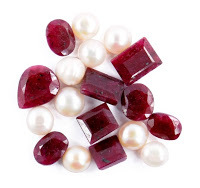 The Rubies & Pearls of Motherhood
The Rubies & Pearls of MotherhoodThere is an important salient point that must needs be added to all of this.
Traditional MOTHERS, and MOTHERHOOD make an essential, irreplaceable contribution to the human condition.
Indeed, traditional Motherhood NEEDS and deserves encouragement, information, validation, and to be unequivocally acknowledged and appreciated the world over.
While essential mommy moxie can come from a variety of authentic directions, and sometimes vital substitutes – it is most enhanced and incomparably received, when it comes from the child’s natural source of life. In truth, no bond could surpass the intensity, keenness and depth of that which is between a healthy and capable biological parent and their child – with all the layers dynamically reinforcing each other – organic, hormonal, emotional, instinctual…and otherwise.
Suffice it to say, in the scope of humanity through time, the vast majority of peoples and places have also ascribed to the idea of this relationship – that of mother and child - as profoundly spiritual, something of divine nature – that which resonates and reaches both from and far beyond this temporal existence…
There is simply no bond more essential, more optimum, more fulfilling, or stronger than that of a healthy, capable mother and her child.
Above all, it is my heart’s deepest desire that everything I write or share about mommy moxie, parenting, family and children - serves to encourage enduring, permeating tenderness, gentle strength, and quiet fortitude in a world where these things are, STILL, perhaps more than they have been in all of human history - more valuable than rubies and pearls.
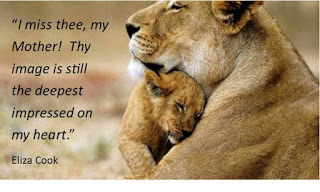
Eliza Cook’s quote, is a great reminder of the hand, or perhaps image, that does indeed, rule the world.
What do you think about Mommy Moxie? How have you seen it played out in your life?
Published on September 27, 2015 09:01
September 26, 2015
Moxie Pizza
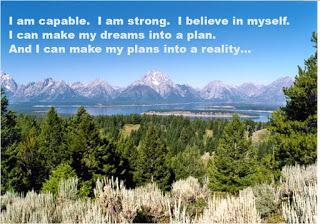 Self-esteem is the key.
Self-esteem is the key.
Self-esteem is the key that unlocks all other doors to success.
Sometimes, self-esteem is interchanged with related terms like: self-care, self-respect, efficacy, self-acceptance, or self-love.
I want to remind you of what you probably already know – but need to think of with the utmost vigor:
IT IS ALL CONNECTED.
It is all connected, it is universal – and for me personally, I put a lot of stock into believing it all flows from the same Source.
Self-esteem is much bigger and more intricate than what we often give it credit for. It is basically an outcropping of many other complex individual traits, layered with personal outlook, decisions and life experiences. Science is revealing many ways that DNA is proving to be a factor. Faith leaders in all times and places would promote its relationship to spiritual matters. Sociologists would tell you it is interdependent with the collective experiences of your various tribes – from ethnicity and nationality, to our esteemed (or not) occupation. A psychologist might suggest it is the sum total of all our perceived previous experiences and what we’ve imprinted from those.
They are all, I believe, right. Self-esteem is all of these things. It’s like eating a loaded pizza. Sure you can take it apart and eat the pepperoni, and then eat the olives, and the peppers. You can even peel off the cheese and slurp it up separately. Go ahead, lick or spoon off that pizza sauce, and then crunch down what is left of the soggy crust. While this certainly can be done, (and often is, in a high chair, or by an uber-picky eater), it isn’t the ideal way – and isn’t the way pizza was meant to be experienced, or savored. Ditto with our self-esteem, as complex and dimensional a puzzle if there ever was one. But oh so essential to, well – everything.
And as you know, every pizza is just a little different. The general ingredients may be the same or even similar, but the recipe, the toppings, the care and the temperature of the oven will all determine the final result. So it is with us.
Moxie: A Family of Terms
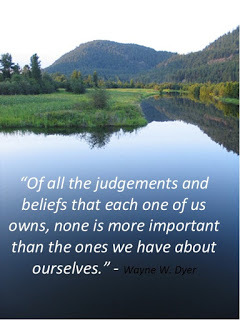
Everything you experience and do is built upon a complex foundation of your self-perception, deeply anchored with all of the other components of what I love to write about…what I love to coax: Moxie.
Consider this topping list for your Moxie Pizza!
Moxie is:
A HEALTHY SELF-CONCEPT
GENUINE SELF-CONFIDENCE
HIGH SELF-ESTEEM
HIGH SELF-EFFICACY
SELF-DISCIPLINE
POSITIVE HABITS
CRITICAL REASONING SKILLS
CREATIVE PROBLEM SOLVING
PERSEVERANCE, PERSEVERANCE, PERSEVERANCE
DEEP GRATITUDE
DEEP STRENGTH, COURAGE & CHARACTER
A BRIGHTNESS OF HOPE
Moxie helps you:
KNOW YOUR STRENGTHS & WEAKNESSES
OVERCOME ADVERSITY
ADJUST PERSPECTIVE
TAKE EFFECTIVE ACTION
STAY ON TRACK
RESPOND POSITIVELY TO CHALLENGES
AVOID THE SELF-PITY, UNFAIRNESS OF LIFE, OR 'WHY ME?' TRAP
ACCEPT ADVERSITY AS PART OF LIFE
PRACTICE THE ART OF SELF-ACCEPTANCE
APPRECIATE ONE’S OWN UNIQUE SPECIALNESS
EMBRACE PERSONAL DEVELOPMENT
DEDICATE TO SELF IMPROVEMENT
DEVELOP TALENTS
MAKE HEALTHY CHOICES
HAVE EXCELLENT GROOMING & SELF- CARE
BE TRUE TO ONE’S-SELF
MANAGE STRESS LEVELS
LIVE WELL
BE SUCCESSFUL
THINK POSITIVELY
VISUALIZE SUCCESS
WORK HARD
PREPARE FOR THE INEVITABLE
Moxie helps you BE:
HUMBLE, INTUITIVE, MOTIVATED, TOLERANT, PATIENT, KIND, FORGIVING
CAPABLE
EFFECTIVE
CONFIDENT
DEDICATED
COMMITTED
DEPENDABLE
GENEROUS TOWARDS OTHERSFAITHFUL
EMPOWERED
SUCCESSFUL
LOVING & LOVED
FULFILLED, SATISFIED, JOYFUL. GRATEFUL, PEACEFUL, CONTENT, WISE, GRACIOUS, BRIGHTABSOLUTELY AMAZING!
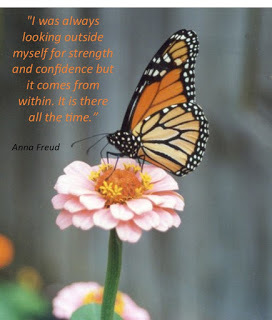
As you can see, moxie is one of my most favorite words. This 5 letter words encompasses so much and can effect such important change in us as individuals on a profound, enduring level.
I would love it if you could share a moxie moment in your own life.
(The Fostering Mom never turns away a good pizza recipe either!)
Published on September 26, 2015 08:52
September 21, 2015
Moxie Comes By Acceptance, Attitude & Action
We must have a basic hope of directing at least SOME aspects of our life in order to satisfy our sense of esteem.
Intrinsic to our core esteem, is an intuitive faith in our ability to impact, and help design our specific life’s conditions according to our will, faith, and desires of the heart. We must believe in our own ever-evolving vision of our life. For example, you can’t choose where you are born and raised – but you can choose, with some varying degree, where you live in the end. You can’t choose the socio-political environment you find your country and community sailing through – but you can choose to navigate it with vigor, and valor.
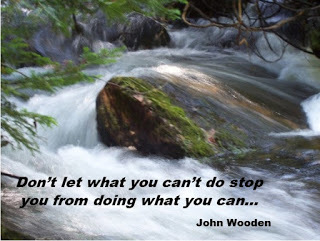
In my work with troubled families, and neglected, abused, and otherwise traumatized children – some of the most humbling and important work I have had the opportunity to be a part of, had to do with simple encouragement. It involved honest, basic change, through hope. The hope that tomorrow really could be different – way better than yesterday, and even better than today.
This kind of hope, indeed – springs from accepting the trials of life with some kind of grace and similitude. This is followed by a permeating, immovable belief that we can control our actions, and that we can in fact choose our posture, thought process and attitude about our circumstances, whatever they may be. We must know deeply, in our bones, that we can make a difference, find a way, and break through whatever barriers we must. We must understand, that even if the problem we face takes time, patience. Stick-with-it-ness, or knowledge and skills we have yet to acquire – so be it! All of this we can do!
The final part, is deepening our understanding of how Acceptance and Attitude result in Action. These all work in tandem – to forge enduring self-esteem, or moxie – as The Fostering Mom calls it.
The All Important Triple-Play
To be hopeful, and have a solid sense of esteem, you need to deeply accept a life-changing TRI-FECTA.
ACCEPTANCE: (This is a biggie!) The first part of this empowering wisdom, is to just simply accept there are conditions beyond your control; things like the weather, the traits, attitudes and overall decisions of others. Just as hard as what Mother Nature brings on, is what human nature throws at us. But we must remember, the personality and life view that is forged by the characteristics and experience of others, is simply not in our (healthy) control. Further, we must admit, after all – we really wouldn’t want it to be, even if it were possible. By the same token, we neither should be, nor really can be responsible for the ultimate choices of others. Then there is illness, disease and age, all downright unsettling to most of us at one time or another. While we can certainly influence contributing factors, we are all forced to accept sooner or later, just how much of a lack of control we actually have over our (inherited) health, and how our bodies respond to inevitable impacts of stress, foreign organisms, the environment – and age.
ATTITUDE: The second part is an embedded, unassailable belief that you can dial your own response, attitude and reaction to any and all of life’s unchangeable circumstances which lie beyond healthy control.
ACTION: Last but not least, to have the sensibilities to figure out how and when to act in either of two ways in response to these challenges - and often a combination. o Externally: to make or stimulate change in others or the environment.
o Internally: to change, grow, adapt, evolve, or settle something within ourselves.
This all important tri-fold of acceptance, attitude, and action is one of the most critical paradigms we must internalize. To what extent we do, largely impacts not only our self-esteem, but our whole outlook – and outcome – in life. This is truly core, not only to success – but sometimes even to survival. Just ask anyone who has braved through a life-threatening illness. Too, this wisdom of the ages echoes from revered, ancient religious scrolls. It is talked of by inspiring Auschwitz survivors in their accounts of (barely) surviving harrowing, unimaginable horrors. Iconic sages, like Ghandi, describe these ideas as inspiring an entire nation of millions to find a way to peacefully revolt, and finally be free of imperialistic oppression. Inspirational guru’s whose brands are practically household names the world over – have built their message around some variation of this universal theme. I would even argue that every world religion and sect that exists today – is more defined than anything else, by what is their variation and detailed explanation of this existential architype.
To go into this further:
1) Part one is self-explanatory: not only are we simply not going to have our way with everything, life isn’t always fair, and things will hit us hard sometimes, unexpectedly. It’s all about the acceptance that, as I once overheard someone I adore say, “life is pain, princess.” Also, we will encounter many others at various stages of accepting, rejecting and internalizing this, sometimes very complex and difficult premise. We may get tempted to, either purposely or unconsciously, exert control in ways that are not healthy for us or others. We also must learn to identify and defend ourselves from others who would do the same. We often need, what The Fostering Mom affectionately dubs, “a do-over.”
2) Part two, is just the belief that no other person’s traits or actions, and none of our life’s circumstances can ever completely strip away the way we choose to look at something, and thus feel about, and act upon it. This you see, is the ultimate belief in ourselves. It is a true, immovable core of self-esteem. It is the confidence that when it seems aspects of our situation will not budge, as will happen from time to time (see part 1) – that we always have some sense of autonomy, or integrity completely separate from our circumstances. It is the ultimate reliance upon our inalienable dignity. We must know that, while everyone feels discouraged sometimes, nothing and no one can really take away all of our hope. It is essential to have a deep understanding that we always, ultimately have possession of the direction of our own thoughts and choices – and by default are both responsible for, and empowered by those. With the only exception being organic illness impairing our faculties. Despite any delusional attempts to override this absolute, such as with recreational mind -altering substances, this truth in fact remains non-negotiable. Just ask any victim of drunk driving, or any other drug-related crime.
3) Understanding these multi-layered ideas, and taking responsibility for them, is incredibly important. We must own this foundation of self-esteem – and truly make it ours. We must clamor to the best examples we can find of it, in the calm, and when the winds of life are howling high. If we allow it to, this most ultimate, freeing power will anchor us sturdily through all. When we accept full responsibility for our own response (and only our response) to those things which we cannot control, it is then we find the grace to not only persevere through whatever we must, but do so with grace, dignity and a persisting, robust and renewing hope.
None of this is a new idea, of course. We’ve all seen versions of these concepts hundreds, maybe thousands of times.
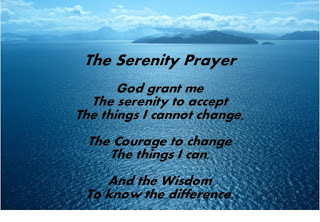
While it may seem trite, it is not. This cannon of inspirational wisdom refers to more than a few substantial principles of success and happiness. The obvious commentary it brings, is the reminder that any problem we face comes with the choice to either attempt change upon external conditions or work to adjust our own internal mindset. Indeed, the space in between to which the poem obviously speaks to, the difference, is what gives most of us the most trouble. However, what may not be so obvious, but is pivotal – is the built-in assumption of hope this famous, modern proverb validates. It doesn’t say “if” we act upon our circumstances – but how. Because, (again, with only the caveat being serious deficits to our faculties), we always have a choice, either internal or external.
Pretty deep, I know. But worth the excursion. Committing our mindset to one of mature acceptance, and then adapting our actions and attitude accordingly, diminishes the minor, everyday setbacks we inevitably face to barely-discernible blips on the radar. When we are filled with this kind of hope and confidence in ourselves, the process becomes natural, and the trivial stays just that, leaving our full attention and energies to focus on that which is decidedly not. Thus our moxie is not only coaxed, but amplified.
Published on September 21, 2015 08:16
September 17, 2015
Coaxing Moxie
“Somehow I can’t believe that there are any heights that can’t be scaled by one who knows the secrets of making dreams come true. This special secret, it seems to me, can be summarized in four Cs. They are curiosity, confidence, courage, and constancy and the greatest of all is CONFIDENCE. When you believe in a thing, believe in it all the way, implicitly and unquestionable.”
– Walt Disney
Walt Disney was a granddaddy of moxie. He was not afraid to put himself out there and to realize his dreams. Moxie is a big part of my life and a running theme for my blog in general. I am passionate about life, love, family and the need for moxie in our lives.
To coax is to gently persuade, softly convince, urge or encourage, and if there is anything in general I, Connie Kerbs, The Fostering Mom, hopes to do, it is to ‘coax’ you to coax some moxie into your life. After all you can never have too much capability, vitality, enthusiasm or competence to name just a few.
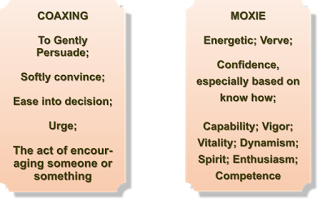
Now self-esteem and self-confidence are what I term the “dynamic duo”; you need both aspects to feature strongly in your life and if you are a parent it is your task to foster these qualities in your children.
Nothing determines a person’s (child’s) outcome or general satisfaction with life, as much as their deep, most basic esteem of themselves.
Self-esteem is the solid foundation that self-confidence is built upon, which in turn fortifies self-esteem. This ongoing, concentric life-process is essential to success, satisfaction and well-being.
This dynamic duo of self-esteem and self-confidence, are first acquired in early development and are heavily influenced through social and emotional life- experiences, especially attachment. As we grow, they will strengthen and develop more by our doing, learning, accomplishing, and through an all-important thing called…persistence.
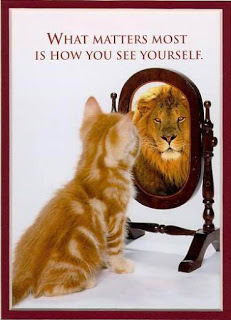 Classic psychology describes self-esteem as: A person's general sense of self-worth or personal value. Self-esteem is considered a personality trait, and while certainly NOT unchangeable, its basis is formed early in life, and is typically stable and enduring.
Classic psychology describes self-esteem as: A person's general sense of self-worth or personal value. Self-esteem is considered a personality trait, and while certainly NOT unchangeable, its basis is formed early in life, and is typically stable and enduring.
Self-esteem involves a variety of deeply intrinsic ideas about the self, such as physical appearance, beliefs, emotions, behaviors, how you perceive others see and feel about you, and your relationship to the main groups to which you belong. It is your general confidence in your own abilities. It is your level of personal independence. It includes your overall view of the importance of your life, and your perceived value of your personal contributions.
What is moxie?
Moxie is the term I use to represent the entire self-esteem “package:” the clusters of interconnected traits, decisions and experiences vibrating at the core of that big ball of self-esteem. It is essential to understand that all these ideas work together in a reciprocal, and incredibly exquisite tandem in your life – and the results look and feel like this:
Moxie is a sincere charm, a legitimate charisma, or a glow of contagious positivity that lights up a room.
Moxie is behind the on-top-of-the-world, just got that hard-won promotion feeling or the awesome, finally - got that long sought after job moment.
Moxie is the momentum behind every home run ever ran, and is what enables a cross country runner to finally beat a personal best time in a race.
Moxie is what helps a struggling fifth grader figure out how to stand up to that class bully, and in doing so, they earn as much self-respect as their new found peer-respect.
Moxie is the victory dance after a touchdown, and is the catalyst for youth in JV sports to make Varsity tryouts.
Moxie is what brings out the “momma bear,” when her instincts tell of her child’s needing her strength and protection.
Moxie is what beckons us to our aging parent’s bedside as they convalesce, knowing they can depend upon us to be there until the end.
Moxie is what finally gives a guy courage to ask an impressive girl out – and what he feels an adrenaline shot of when she says yes.
Moxie is the explosive joy when he proposes sometime later - and the girl says yes again.
Moxie is what motivates a couple whose marriage is feeling overwhelmed (or underwhelmed, as the case may be) – to successfully set things right, and get their life, relationship, and their family back on steady ground.
Moxie is what helps us steer our “ship,” through the tsunamis and hailstorms of life.
Moxie makes the only real, lasting joy - a sense of deep satisfaction based on gumption, gratitude, and grace.
All this, and more is why The Fostering Mom is dedicated to coaxing moxie.
What does moxie mean to you?
Walt Disney was a granddaddy of moxie. He was not afraid to put himself out there and to realize his dreams. Moxie is a big part of my life and a running theme for my blog in general. I am passionate about life, love, family and the need for moxie in our lives.
To coax is to gently persuade, softly convince, urge or encourage, and if there is anything in general I, Connie Kerbs, The Fostering Mom, hopes to do, it is to ‘coax’ you to coax some moxie into your life. After all you can never have too much capability, vitality, enthusiasm or competence to name just a few.

Now self-esteem and self-confidence are what I term the “dynamic duo”; you need both aspects to feature strongly in your life and if you are a parent it is your task to foster these qualities in your children.
Nothing determines a person’s (child’s) outcome or general satisfaction with life, as much as their deep, most basic esteem of themselves.
Self-esteem is the solid foundation that self-confidence is built upon, which in turn fortifies self-esteem. This ongoing, concentric life-process is essential to success, satisfaction and well-being.
This dynamic duo of self-esteem and self-confidence, are first acquired in early development and are heavily influenced through social and emotional life- experiences, especially attachment. As we grow, they will strengthen and develop more by our doing, learning, accomplishing, and through an all-important thing called…persistence.
 Classic psychology describes self-esteem as: A person's general sense of self-worth or personal value. Self-esteem is considered a personality trait, and while certainly NOT unchangeable, its basis is formed early in life, and is typically stable and enduring.
Classic psychology describes self-esteem as: A person's general sense of self-worth or personal value. Self-esteem is considered a personality trait, and while certainly NOT unchangeable, its basis is formed early in life, and is typically stable and enduring.
Self-esteem involves a variety of deeply intrinsic ideas about the self, such as physical appearance, beliefs, emotions, behaviors, how you perceive others see and feel about you, and your relationship to the main groups to which you belong. It is your general confidence in your own abilities. It is your level of personal independence. It includes your overall view of the importance of your life, and your perceived value of your personal contributions.
What is moxie?
Moxie is the term I use to represent the entire self-esteem “package:” the clusters of interconnected traits, decisions and experiences vibrating at the core of that big ball of self-esteem. It is essential to understand that all these ideas work together in a reciprocal, and incredibly exquisite tandem in your life – and the results look and feel like this:
Moxie is a sincere charm, a legitimate charisma, or a glow of contagious positivity that lights up a room.
Moxie is behind the on-top-of-the-world, just got that hard-won promotion feeling or the awesome, finally - got that long sought after job moment.
Moxie is the momentum behind every home run ever ran, and is what enables a cross country runner to finally beat a personal best time in a race.
Moxie is what helps a struggling fifth grader figure out how to stand up to that class bully, and in doing so, they earn as much self-respect as their new found peer-respect.
Moxie is the victory dance after a touchdown, and is the catalyst for youth in JV sports to make Varsity tryouts.
Moxie is what brings out the “momma bear,” when her instincts tell of her child’s needing her strength and protection.
Moxie is what beckons us to our aging parent’s bedside as they convalesce, knowing they can depend upon us to be there until the end.
Moxie is what finally gives a guy courage to ask an impressive girl out – and what he feels an adrenaline shot of when she says yes.
Moxie is the explosive joy when he proposes sometime later - and the girl says yes again.
Moxie is what motivates a couple whose marriage is feeling overwhelmed (or underwhelmed, as the case may be) – to successfully set things right, and get their life, relationship, and their family back on steady ground.
Moxie is what helps us steer our “ship,” through the tsunamis and hailstorms of life.
Moxie makes the only real, lasting joy - a sense of deep satisfaction based on gumption, gratitude, and grace.
All this, and more is why The Fostering Mom is dedicated to coaxing moxie.
What does moxie mean to you?
Published on September 17, 2015 07:56
September 9, 2015
Back To School Blues
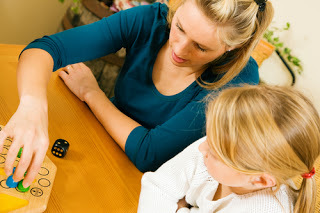
Back-To-School: A Reset Button That Actually Works
Ready or not – it’s that time of year again. Homeschoolers, private schoolers, charter schoolers, and public schoolers everywhere are embarking on the next chapter in their educational journey followed closely by their parents! So, how can we best help our charges to adjust to what can feel like a shock after all that blissful free-time and hazy-lazy-days of summer at the pool, mall, or lake.
Give your children the gift of an established schedule; a regular bedtime, wake time, meal time, and yes, chore time. Trust me on this! Everything else, including homework will fall into place if this can be consistently accomplished. I know, easier said than done – but oh so worth it!
A Reset Button
To help with this, I want to share where it starts. I am going to propose to you, something I discovered with foster children who came to me with the idea of structure and routines being as foreign as escargot. Funny thing, after seeing how it threw me a life-line with the extreme anti-routine bodies, I discovered it works like a charm with ALL kiddos! I am going to offer you a once given, but now a novel idea. It doesn’t start with the getting ready for bed routine, the teeth brushing, creatively resisted PJ reminders, frustrated prodding efforts of homework or the bedtime story on mom’s Kindle. It starts with the evening reset button.
So just what is this magic button that might be a game changer in your family’s routine? It’s an idea as old as time – probably even more deeply imbedded into our DNA than we realize. Which is why it works so well! Not very long ago, it was called story-telling time, or parlor time, depending on where you lived. If you were lucky, you had an old spinet to help carry the tune, or a talented story-teller (called a shaman in some circles).
The Gathering
It’s simple really. Humans are social creatures. For thousands of years, in communities, and even little isolated families, the world over – we just simply gathered at the end of the day. Gathering for family reading time (easy stuff, like the Bible, the Koran, or the Tora - depending on which corner of the globe your ancestors hailed from) or around simple fires in clusters of kin. Sometimes it was more rowdy, and might involve dancing, singing, or chanting. But it happened on a regular basis – and involved something rare and precious on the modern parenting landscape: eye contact, body language, touching, laughing – and pretending, playing and being silly together. Every culture has their version of this routine in their heritage.
And then, at least in the modern Western world – the 1930s, 40s and 50s happened. With the advent of modern television. Everything was ok at first. The family gathered, as they had been for years around the radio, to listen to, (but now with moving pictures!) –something for the whole family. Then, slowly – as families got more than one TV, and other things favoring “individual time,” competed for social gathering time as never before. Slowly, but surely, the age-old routine of the end of the day gathering has dissipated. However, not without consequences.
The solution: establish a regular evening relaxation routine for your family. Some activity everyone, or almost everyone, can clamor to and join in. Family game time, audio book hour in the family room, a family walk, or – family music jam time! Yes, it can even be family TV time; the keyword – being FAMILY. What is important is to find something familiar, and low maintenance that all ages and stages can relax into – even if resistant at first. Be creative!
Be Honest
You can’t lie to your children – their fake-meter is off the chart, especially when it comes to their parents. Pick something you will truly enjoy sharing with them perhaps a passion of yours or a hobby. The more corny, playful, juvenile, or nerdy (by today’s standards) – the better. There are huge dividends to be had on this one! If you do go with screen time – I would suggest “retro TV,” – just because it is a little different, (thus engaging, in a quirky way), and often more wholesome for all ages than modern programming can be. Something gently humorous and entertaining, without Hollywood’s version of dysfunctional parenting and the bratty, disrespectful behavior it produces.
Enjoy It
The key to all of this is enjoyment. People didn’t gather just to relax. They didn’t gather for some personal gain or an agenda in mind. They gathered to just BE and enjoy each other. To make music, entertain one another, tell stories, and nurture each other. In real, physical time and place. This strengthened social bonds and fostered communication, teamwork, and self-esteem. And it was FUN!
Now – this is where the big, short-term, tangible payoff comes in; a healthy side-effect of all this social time is the dopamine it produces resulting in deep relaxation, a pre-requisite of the nighttime/bedtime routine missing the battle element. See where I am going with all of this? A modern argument for an age-old routine, or nightly RESET BUTTON as I prefer to call it.
So mother hens, collect your chicks and gather them in family rooms or at the kitchen table. Do something enjoyable for 30-60 minutes as often as you can; every night if possible. If you have toddlers this might look different than if you have a house full of tweens. If you are outdoorsy this might feel very different than if you are an academically oriented family. You can do this. The most important thing is right there, in real time, in front of you. We must not miss it so that we can send 3D memes 10 years from now on the future’s next revolution in social media about how quickly the time of raising our families passed. But that is another blog post. Or two.
Published on September 09, 2015 14:14
June 23, 2015
Look! A Book! "You're Just What I Need."
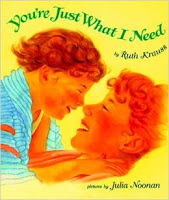 Image Courtesy, Wiki CommonsHow about a good snuggly read with a favorite child, ages 3 - 8, and Krauss/Noonan’s timeless classic, Your’e Just What I Need? (Adapted from the original 1951, The Bundle Book, Harper & Row.)
Image Courtesy, Wiki CommonsHow about a good snuggly read with a favorite child, ages 3 - 8, and Krauss/Noonan’s timeless classic, Your’e Just What I Need? (Adapted from the original 1951, The Bundle Book, Harper & Row.) Nurturing through story-telling just does not get any better than getting lost in the modern version (1998, Harper Collins) of this delightful re-release. This celebration of everything that a great, classic picture book should be, captures an everyday child/parent moment of peek-a-boo. With gorgeous, soft and expressive illustrations, and a comfortable, (like flannel-pajamas in winter, or chocolate chip cookies comfortable), repetitive text that playfully teases along the familiar game every child knows - this classic is a treasure. If I had a wish, it would be that every child would have books like this in their own little library, and more than that - that they would have a caring adult to share the delightful experience this book is, in a nurturing, playful way with them. Although, I am not sure who would enjoy it more - the child, or the adult.
I discovered this gem with the last wave of my children who were still young enough to appreciate it - and it remains one of our favorite reading memories." May it give you the same riches.
Youre-Just-What-I-Need, by Krauss/Noonan
Published on June 23, 2015 15:00



